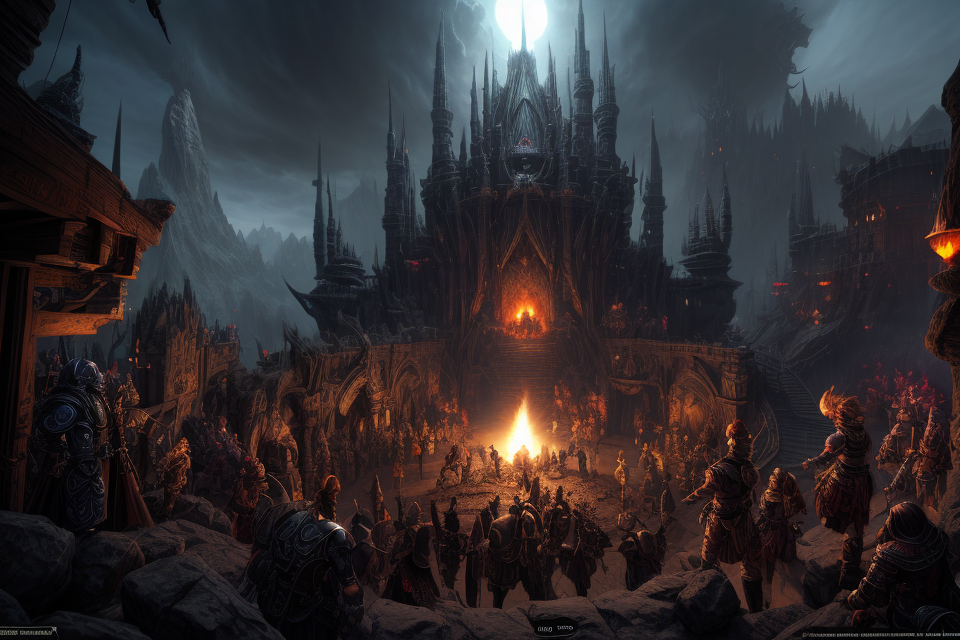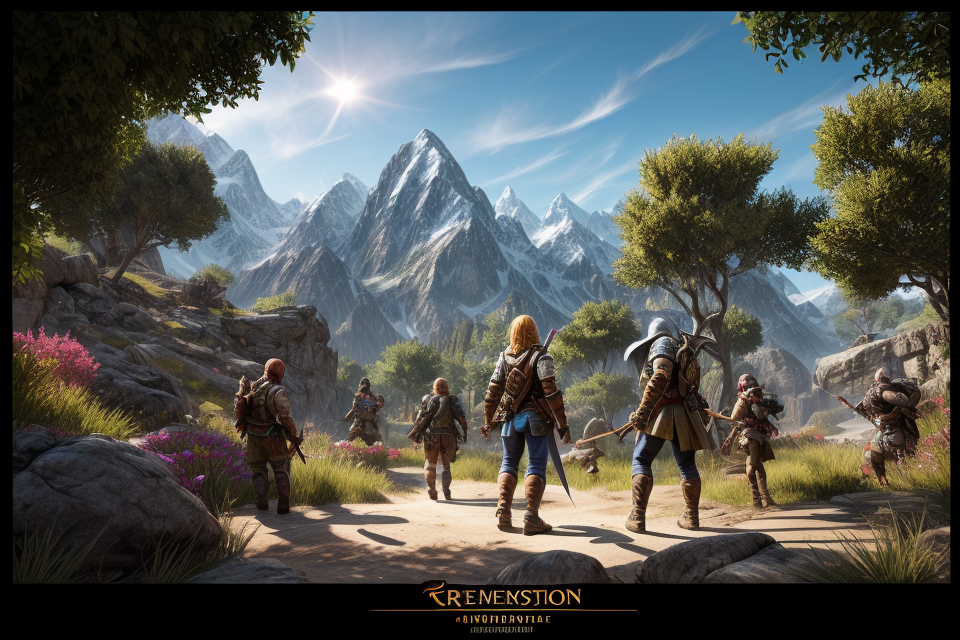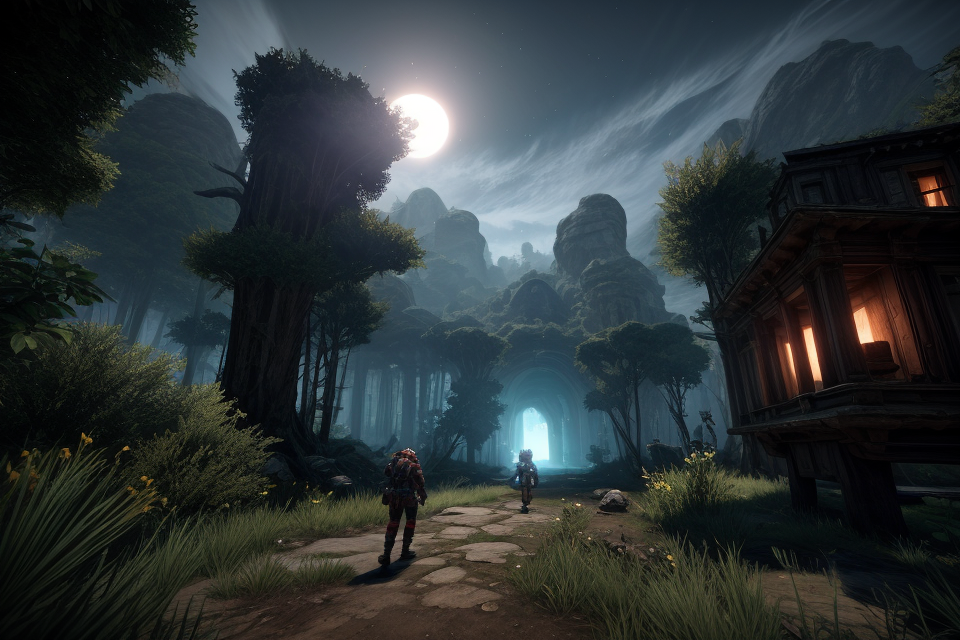Welcome to Baldur’s Gate 3, the latest installment in the beloved Baldur’s Gate series! For those new to the game, the question of “What should I do in Baldur’s Gate 3?” can be overwhelming. With so many options and paths to choose from, it can be difficult to know where to start. But fear not, brave adventurer! This comprehensive guide is here to help you navigate the vast world of Baldur’s Gate 3 and make the most of your journey. From choosing your character and customizing your abilities, to exploring the city and embarking on quests, we’ll cover everything you need to know to get started in this exciting new game. So grab your sword, put on your armor, and let’s begin!
Understanding the Basics
Character Creation
Creating a character in Baldur’s Gate 3 is an essential part of the game as it determines your character’s abilities, skills, and traits. The following are the key elements to consider when creating your character:
Choosing a Race
Baldur’s Gate 3 has a variety of races to choose from, each with its unique abilities and traits. The most popular races include humans, dwarves, elves, and halflings. Your choice of race will determine your character’s starting stats, abilities, and skills. For example, dwarves are strong and sturdy, making them excellent fighters, while elves are agile and nimble, making them better suited for ranged combat.
Aligning your Character
In Baldur’s Gate 3, your character’s alignment determines their moral and ethical values. You can choose to be lawful, neutral, or chaotic good, lawful evil, or chaotic evil. Your alignment will affect how NPCs react to you and how certain quests unfold. For example, a chaotic evil character may have more options for evil acts, while a lawful good character may have more opportunities for good deeds.
Selecting your Background
Your character’s background determines their social class, education, and occupation. This affects your character’s starting equipment, abilities, and skills. For example, a noble character may start with more wealth and better equipment, while a peasant character may have more survival skills.
When creating your character, it’s important to consider your playstyle and the type of character you want to play. For example, if you want to be a spellcaster, you may want to choose a race with high intelligence and a background that provides access to magic. If you want to be a rogue, you may want to choose a race with high dexterity and a background that provides stealth and thievery skills.
In summary, character creation in Baldur’s Gate 3 is an essential part of the game as it determines your character’s abilities, skills, and traits. When creating your character, consider your playstyle, choose a race with the right abilities and skills, align your character with your moral and ethical values, and select a background that provides access to the skills and abilities you want to use.
Navigating the Menus
When starting a new game in Baldur’s Gate 3, it can be overwhelming to navigate through the various menus and options available. However, with a little guidance, you can quickly become familiar with the game’s user interface and navigate through the menus with ease.
User Interface Overview
The user interface in Baldur’s Gate 3 is designed to provide players with all the necessary information at a glance. The main interface consists of several sections, including the party menu, inventory, map, quest journal, and character statistics. Each section is clearly labeled and can be accessed by clicking on the corresponding icon.
Quick Slots and Inventory Management
Managing your inventory in Baldur’s Gate 3 is made easy with the game’s quick slots system. Each character has six quick slots, which can be used to store frequently used items. To access the quick slots, simply click on the corresponding icon in the user interface.
In addition to the quick slots, players can also access their inventory by clicking on the inventory icon in the user interface. The inventory screen is organized into several sections, including weapons, armor, trinkets, and consumables. Players can sort and filter their inventory by clicking on the appropriate buttons.
Map and Journal Functionality
The map and journal are two essential tools for navigating the world of Baldur’s Gate 3. The map displays the player’s current location, as well as any notable locations, quests, and enemies in the surrounding area. Players can zoom in and out of the map by clicking on the magnifying glass icon or by using the mouse wheel.
The journal is where players can view their current quests, as well as any side quests and optional content available in the game. Players can filter their quests by status, location, and type, making it easy to find the quests they need to complete.
By understanding the basics of navigating the menus in Baldur’s Gate 3, players can quickly become familiar with the game’s user interface and focus on enjoying the game’s immersive world and engaging story.
Combat Mechanics
Understanding the basics of combat mechanics in Baldur’s Gate 3 is crucial for survival in the game. Here are some important points to keep in mind:
- Understanding Attack and Defense: In Baldur’s Gate 3, the attack and defense mechanics are interconnected. Each character has an armor class (AC) that determines how difficult it is for enemies to hit them. Players need to balance their characters’ offense and defense to ensure their survival in combat.
- Movement and Positioning: Movement and positioning are critical in combat. Players need to be aware of their surroundings and make strategic decisions about where to move and position themselves. For example, taking cover behind a wall or using terrain to gain an advantage can help players avoid enemy attacks.
- Skills and Abilities: Characters in Baldur’s Gate 3 have a variety of skills and abilities that can be used in combat. These can include melee and ranged attacks, spells, and abilities that can enhance character abilities or debilitate enemies. Players need to understand how to use these skills and abilities effectively to emerge victorious in combat.
Getting Started with the Story
Prologue and Tutorial
The Prologue and Tutorial in Baldur’s Gate 3 serve as the introduction to the game’s story and mechanics. It is important to complete these sections thoroughly to ensure a smooth and enjoyable gaming experience.
Completing the Prologue
The Prologue is the opening sequence of the game, and it sets the stage for the story to come. It is recommended to take your time and carefully observe the environment, dialogue, and characters during this section. The Prologue provides important context and introduces key elements of the game’s story.
Understanding the Tutorial
The Tutorial is a guided section that teaches players the basics of gameplay mechanics, including movement, combat, and character customization. It is crucial to pay close attention to the instructions provided during the Tutorial to ensure a strong foundation for the rest of the game.
Meeting Your Companions
As you progress through the Prologue and Tutorial, you will encounter several companions who will join your party. These characters each have unique personalities, abilities, and backgrounds, and they will play a significant role in your journey throughout the game. It is important to familiarize yourself with your companions and understand their strengths and weaknesses to make the most of their skills in combat and exploration.
Exploring the World
Baldur’s Gate 3 offers a vast and immersive world for players to explore. As a beginner, it can be overwhelming to navigate through the game’s vast open-world environment. This section will provide a brief overview of the game’s world map, towns, cities, and campsites, as well as quests and side missions.
Baldur’s Gate 3’s World Map
The world map in Baldur’s Gate 3 is a vast and detailed environment that players can explore. The map is divided into different regions, each with its own unique features and challenges. Players can travel between regions by foot, horseback, or boat, and can interact with various landmarks and points of interest along the way.
Towns, Cities, and Campsites
Throughout the game, players will encounter various towns, cities, and campsites. Each location has its own unique character and culture, and players can interact with NPCs, engage in quests, and discover hidden treasures and secrets. Some notable locations include:
- Baldur’s Gate: The capital city of the Sword Coast, Baldur’s Gate is a bustling metropolis filled with merchants, adventurers, and intrigue.
- Candlekeep: An ancient library and fortress, Candlekeep is home to powerful magic and knowledge, but also holds dark secrets and dangers.
- Neverwinter: A large city on the Sword Coast, Neverwinter is rebuilding after a devastating war and is filled with opportunities for adventure and exploration.
- Luskan: A pirate city on the coast of the Sword Coast, Luskan is known for its dangerous underworld and treacherous politics.
- The Wilds: A vast wilderness area, the Wilds is home to dangerous creatures, ancient ruins, and hidden treasures.
Quests and Side Missions
Baldur’s Gate 3 is filled with quests and side missions for players to undertake. These range from simple fetch quests to complex, multi-part adventures that can take hours to complete. Some notable quests include:
- The Sleeping King: A quest to awaken a long-dormant king and restore order to a troubled kingdom.
- The Death House: A haunted mansion filled with deadly traps and terrifying monsters, the Death House is a challenging adventure for brave adventurers.
- The Forgotten Temple: An ancient temple hidden deep in the jungle, the Forgotten Temple holds powerful artifacts and dangerous secrets.
- The Catacombs of the Black Pyrate: A dark and dangerous underground lair, the Catacombs are home to pirate treasure and deadly traps.
Exploring the world of Baldur’s Gate 3 is a thrilling and rewarding experience for players of all levels. With its vast open-world environment, intricate storylines, and diverse locations, the game offers endless opportunities for adventure and discovery.
Building Your Party
Recruiting Companions
When starting your journey in Baldur’s Gate 3, one of the first tasks you’ll need to complete is assembling a party of companions to accompany you on your adventures. These companions can be recruited from various locations throughout the game, including:
- The Ritualist: A powerful mage who specializes in controlling the elements and casting powerful spells.
- The Fighter: A skilled warrior who excels in close combat and can wield a variety of weapons and armor.
- The Rogue: A stealthy character who excels at sneaking, lockpicking, and disarming traps.
- The Cleric: A holy warrior who can heal allies and wield divine magic to smite enemies.
Balancing Party Roles
Once you have recruited your companions, it’s important to ensure that each member of your party has a unique set of skills and abilities that complement one another. This will allow you to tackle a variety of challenges and overcome any obstacles that may stand in your way.
For example, if you have a strong fighter in your party, you may want to also include a cleric or a rogue to provide support and healing in battle. Similarly, if you have a rogue in your party, you may want to include a fighter or a cleric to provide additional damage output or healing capabilities.
Managing Relationships
In addition to balancing party roles, it’s also important to manage the relationships between your companions. This can include resolving conflicts, building trust, and making important decisions that will affect the course of your adventure.
For example, you may need to decide whether to trust a mysterious stranger or betray an old friend. These decisions can have a lasting impact on your companions and the story as a whole, so it’s important to choose wisely.
Overall, building a strong and balanced party is crucial to success in Baldur’s Gate 3. By recruiting a diverse range of companions, balancing their roles, and managing their relationships, you’ll be well on your way to conquering the challenges that lie ahead.
Enhancing Your Gameplay Experience
Character Progression
In Baldur’s Gate 3, character progression plays a significant role in shaping your gaming experience. Here are some essential aspects of character progression that you should be aware of:
Leveling Up and Skill Trees
As you progress through the game, your characters will gain experience points (XP) and level up. Each time your character levels up, they gain a point that can be allocated to increase their abilities and skills. There are multiple skill trees for each character class, and each tree has unique abilities and bonuses.
You should consider the following factors when deciding how to allocate your skill points:
- Your preferred playstyle
- The role you want your character to play in your party
- The strengths and weaknesses of your party members
Distributing Attribute Points
At the beginning of the game, you will be asked to distribute attribute points among your character’s primary attributes: Strength, Dexterity, and Intelligence. These attributes affect your character’s combat abilities, spellcasting, and other skills.
It is crucial to distribute attribute points wisely, considering the character class you have chosen and the playstyle you prefer. For example, a melee character should prioritize Strength, while a spellcaster should prioritize Intelligence.
You can also increase your attributes by wearing equipment that enhances them.
Crafting and Enchanting
Crafting and enchanting are essential aspects of character progression in Baldur’s Gate 3. You can use resources like gold, ingredients, and blueprints to craft weapons, armor, and other items. Crafting allows you to create items with specific stats and properties that suit your playstyle and character build.
Enchanting involves imbuing items with magical properties. You can use enchanting tablets or scrolls to enchant your equipment, which can significantly boost your character’s abilities.
In conclusion, character progression is a critical aspect of Baldur’s Gate 3, and understanding how to allocate your skill points, distribute attribute points, and craft and enchant items can significantly enhance your gaming experience.
Combat Tactics
Baldur’s Gate 3 offers a rich and complex combat system that requires careful planning and execution to succeed. Here are some combat tactics that can help you enhance your gameplay experience:
Flanking and Positioning
Flanking is a powerful tactic that allows your characters to gain an advantage in combat. To flank, characters must be positioned at opposite sides of a creature, which grants them an additional attack and a +2 bonus to their attack rolls. Positioning is crucial in combat, and you should always try to flank when possible.
Crowd Control and Utility
Crowd control is essential in Baldur’s Gate 3, as it allows you to manage the battlefield and keep your characters alive. Some useful crowd control abilities include stuns, knockdowns, and fear effects. Utility spells like invisibility and blur can also be very helpful in combat.
Strategies for Boss Fights
Boss fights in Baldur’s Gate 3 can be challenging, and you’ll need to employ different strategies to defeat them. One useful tactic is to focus on the boss’s weak points and use crowd control to keep them vulnerable. It’s also important to manage your characters’ health and avoid taking unnecessary risks. Using environmental hazards and traps can also be very effective in boss fights.
Exploration and Puzzles
Exploration and puzzles are essential elements of the Baldur’s Gate 3 gameplay experience. In this section, we will discuss various techniques and strategies to enhance your exploration and puzzle-solving skills.
Secrets and Hidden Objects
Baldur’s Gate 3 is full of secrets and hidden objects that can be easily missed by players. These objects can include hidden doors, secret rooms, and hidden treasures. To discover these secrets, players must be observant and pay close attention to their surroundings. One effective technique is to search every corner of the room, including walls, floors, and ceilings, for hidden triggers or switches.
Another approach is to use the “search” function in the game, which allows players to look for specific items or clues. This function can be particularly useful when searching for hidden objects or secrets. Additionally, players can also use the “investigate” function to examine objects in more detail, which can reveal hidden clues or secrets.
Understanding Traps and Locks
Traps and locks are an integral part of the game and can be found throughout the game world. Understanding how to disable or avoid traps and locks is essential to progressing through the game. One technique is to look for clues or hints that can help identify the type of trap or lock and how to disable it.
Players can also use their wits and try different approaches to disable traps and locks. For example, players can try to find the source of the trap or lock and disable it from there. Alternatively, players can try to use their surroundings to disable the trap or lock, such as using an object in the environment to disable the trap.
Puzzle Solving Techniques
Puzzles are a common feature in Baldur’s Gate 3 and can range from simple to complex. To solve puzzles, players must use their problem-solving skills and think creatively. One technique is to examine the puzzle closely and look for clues or hints that can help solve it.
Players can also try different approaches to solve puzzles. For example, they can try to find patterns or connections between objects or events. Additionally, players can use their surroundings to solve puzzles, such as using objects in the environment to solve the puzzle.
Overall, exploration and puzzles are crucial elements of the Baldur’s Gate 3 gameplay experience. By using the techniques and strategies discussed in this section, players can enhance their exploration and puzzle-solving skills and enjoy a more immersive and rewarding gameplay experience.
Multiplayer and Co-op
Baldur’s Gate 3 offers an immersive multiplayer experience, allowing players to team up and embark on an adventure together. Here’s a detailed guide on how to join or host a game, work with other players, and communicate and coordinate effectively.
Joining or Hosting a Game
If you’re interested in playing with others, you have two options: join an existing game or host your own. To join a game, simply click on the “Multiplayer” button on the main menu, and you’ll be prompted to enter a game code or search for a game using a unique identifier. Once you’ve found a game you’d like to join, click on “Join Game” and wait for the host to accept your request.
If you’d like to host your own game, click on the “Multiplayer” button and select “Host Game.” You’ll need to choose a name for your game, set the difficulty level, and decide whether you want to allow others to join your game via a game code or unique identifier. Once you’ve set up your game, you can invite friends or share the game code with others who are interested in joining.
Working with Other Players
When playing with others, it’s important to work together as a team and communicate effectively. This means coordinating your actions, sharing information about your character’s abilities and equipment, and helping each other out when needed.
One useful feature in Baldur’s Gate 3 is the “Party” system, which allows you to group your characters together and manage them as a team. To access the Party system, click on the “Party” button on the main menu, and you’ll be able to view and manage your characters’ equipment, abilities, and inventory.
It’s also important to establish clear communication with your teammates. This means using in-game chat or voice communication to discuss strategy, coordinate actions, and share important information. It’s a good idea to establish a shared vocabulary or set of signals to help ensure everyone is on the same page.
Communication and Coordination
Effective communication and coordination are key to success in multiplayer games. This means being clear and concise in your instructions, listening carefully to your teammates, and adapting your strategy on the fly as needed.
One useful tool in Baldur’s Gate 3 is the “Party Command” system, which allows you to issue commands to your entire party. To access this system, type “party command” into the chat window, and you’ll be able to issue commands like “move to” or “attack” to your entire party.
It’s also important to pay attention to your teammates’ actions and reactions, and adjust your strategy accordingly. This means being flexible and adaptable, and being willing to change your approach if something isn’t working.
Overall, multiplayer and co-op play in Baldur’s Gate 3 can be a rewarding and engaging experience, but it requires careful coordination and communication. By following these tips and working together as a team, you’ll be well on your way to success in the world of Baldur’s Gate.
FAQs
1. What is Baldur’s Gate 3?
Baldur’s Gate 3 is a role-playing video game set in the Dungeons & Dragons universe. It is the third installment in the Baldur’s Gate series and was developed by Larian Studios. The game is set in the Forgotten Realms campaign setting and follows the story of a group of adventurers as they explore the Sword Coast and battle against various enemies.
2. What is the story of Baldur’s Gate 3?
The story of Baldur’s Gate 3 begins with the player character being captured by the Mind Flayers, a powerful and evil race of creatures. The player must then work to uncover the plot of the Mind Flayers and stop them from achieving their goals. Along the way, the player will encounter a variety of characters, both friendly and hostile, and will have the opportunity to explore the world of the Forgotten Realms.
3. How do I control my character in Baldur’s Gate 3?
In Baldur’s Gate 3, you control your character using a combination of keyboard and mouse inputs. You can move your character using the arrow keys or WASD, and you can interact with objects and other characters using the mouse. You can also use hotkeys to quickly access certain abilities or items.
4. How do I create a character in Baldur’s Gate 3?
To create a character in Baldur’s Gate 3, you must first choose a race and a class for your character. There are a variety of races and classes available, each with their own unique abilities and strengths. You can then customize your character’s appearance and attributes, such as their strength, dexterity, and intelligence.
5. What are some tips for playing Baldur’s Gate 3?
Here are a few tips to help you get started in Baldur’s Gate 3:
* Make sure to save your progress frequently, as the game can be quite challenging at times.
* Take the time to explore the world and talk to NPCs, as they can provide valuable information and quests.
* Try to balance your party’s abilities and equipment, as this will make the game more enjoyable and easier to play.
* Be prepared for battles, as they can be challenging and require strategic thinking.
* Don’t be afraid to try different approaches to quests and battles, as there may be multiple ways to solve a problem or defeat an enemy.



